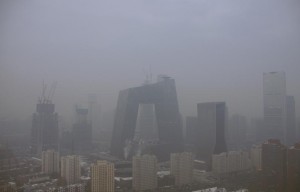In State College, I always think that the air here is pretty fresh, and I feel very comfortable with blue sky, white clouds and beautiful sunshine. However, in North China, the outside environment is totally different. A large blanket of brown haze has settled over North China, especially in the big cities because industries emit in the air pollutant. In the daily life, many people choose to wear masks outside and have air home purifiers to protect their respiratory tracts and lungs. Under this condition, can haze affects people’s mood?
A large blanket of brown haze has settled over North China, especially in the big cities because industries emit in the air pollutant. In the daily life, many people choose to wear masks outside and have air home purifiers to protect their respiratory tracts and lungs. Under this condition, can haze affects people’s mood?
Many people may have the experience that often feel cheerful on sunny days and feel down on dreary days. If this experience appears frequently, even affect normal activities, people should pay attention and find a psychiatrist to consult that whether they have SAD. SAD, seasonal affective disorder is a type of depression that occurs during the same season each year. If you have SAD, your symptoms would start in the fall, and continue into the winter months, sapping your energy and making you feel moody. But, you will feel much better in spring and summer. The specific cause of seasonal affective disorder remains unknown. Some factors that may come into play include: circadian rhythm, serotonin levels, and melatonin levels. To be specific, the period of sunlight reduce in fall and winter. This decrease in sunlight may disrupt body’s internal clock and lead to feelings of depressions. Also, reduced sunlight can cause a drop in serotonin which affects mood, and may trigger depression. Lastly, the change in season can disrupt balance of the body’s level of melatonin, which plays a role in mood and sleep patterns. The study scientists did in Ohio State University prefers the third factor, the level of melatonin.
Three people suicided, in Beijing, China, in one day of 2014 when Beijing was in a pollution haze. So, can haze cause seasonal affective disorder, and then induce suicide? Vice professor Jie Zhong in Psychology of Peking University said that although melatonin levels are related to depression, this kind of influence usually exist in the high latitude regions having polar daylight and polar night, such as Russia, Norway and Denmark. Therefore, he said that haze is just an excuse for depression. From my perspective, this conclusion has no any evidence or experiment to support, so it is not convincing.
haze. So, can haze cause seasonal affective disorder, and then induce suicide? Vice professor Jie Zhong in Psychology of Peking University said that although melatonin levels are related to depression, this kind of influence usually exist in the high latitude regions having polar daylight and polar night, such as Russia, Norway and Denmark. Therefore, he said that haze is just an excuse for depression. From my perspective, this conclusion has no any evidence or experiment to support, so it is not convincing.
Now can we believe that haze has no any relation with depression? No. Scientists have studied the topic of relationship between mood and suicide since the beginning of 20th century. The purpose of that study was to evaluate the hypothesis that sunshine exposure may trigger suicidal behavior. Hence they found that sunshine may have a triggering effect on suicide, and suggests further research in the field of sunshine-regulated hormones, particularly melatonin.
An article published in International Journal of Biometeorology in 2013, studied the citizens in Be’er Sheva, Israel.The main objective of this study was to evaluate the role of the concentration of solid air-suspended particles (SSP) in the incidence of mental disorders. In this area, the desert air streams which bring with an increased concentration of SSP, appear to be complicated stressors that can excite the multiple breaches in psychological state of weather sensitive persons ( such as ideation, mental derangement, depression, nervous tension, and emotional conflicts). Some of these reactions have several accompanying effects, such as a higher prevalence of attempted suicide consistently associated with depression or violation of routine behavior and nervous tension followed by serious consequences in mental dysfunctions.
What’s more, a research group from Canada and a research group from Seoul National University have done similar studies. The results from Canadian research group indicate a potential association between air pollution and emergency department visits for suicide attempts by collecting emergency visit data in a hospital in Vancouver, Canada. The study in SNU is called “Long-Term Fine Particulate Matter Exposure and Major Depressive Disorder in a Community-Based Urban Cohort”. And its subjects are 560 elders in a local welfare house. Its result is that long-term PM2.5 exposure increased the risk of MDD among the general population. But in my opinion, the subjects limit to some extent the generalization of the findings made in the study. So we can only regard it as a reference.
From here we see that there is some correlations between haze and depressive disorder, but we cannot conclude that haze can induce or lead to depressive disorder. We need more specific and rigorous experiments to find the causality. However, in some degrees, people cannot ignore this possibility.
